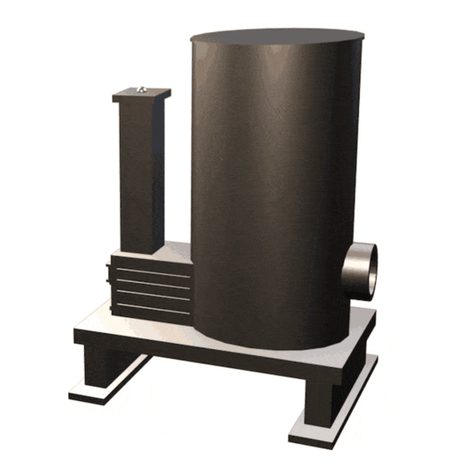Chimney Connection
Masonry Chimney
The masonry chimney must comply with UL or equivalent NRTL and NFPA 211 standards and codes. Before using
an existing masonry chimney, clean the chimney and inspect the flue liner to be absolutely sure it is safe to use.
Rules For Connecting To A Masonry Chimney
1. Use a minimum of 3-1/2" inch brick masonry wall framed to a combustible wall. A fireclay liner
(ASTM 13 or equivalent) having a /8" inch minimum wall thickness must be used and it must
be at least 12" inches (1' foot) away from any material that could catch fire. The inside diameter
of the fire clay liner shall be sized for the proper snug fit to a 6" inch diameter chimney
connector pipe. The fireclay liner shall run to, but not beyond, the inner surface of the chimney
flue and be firmly cemented in place.
2. Use a solid insulated listed factory built chimney length having an inside diameter of 6" inches
and having 1" inch or more of solid insulation. There must be at least a 9" inch air space
between the outer wall of the chimney length and any combustible materials. The inner end of
the chimney length shall be flush with the inside of the masonry chimney flue which shall be
sealed to the flue and to the brick masonry penetration with non water-soluble refractory
cement. Flash sheet steel supports which are at least 24 gauge (0.02 " inches) in thickness shall
be securely fastened to wall surfaces on all sides. Fasteners between supports and the chimney
length shall not penetrate the chimney liner.
3. Use a 10" inch diameter ventilated thimble made of at least 24 gauge (0.02 " inch) steel having
two (2) 1" inch air channels. The ventilated thimble must be separated from combustible
materials by at least 6" inches of glass fiber insulation. The opening in the combustible wall
shall be covered and the thimble supported with sheet steel supports which are at least 24 gauge
(0.02 " inch) in thickness. The sheet steel supports shall be securely fastened to wall surfaces
on all sides and shall be sized to fit and hold the chimney section. Fasteners used to secure
chimney sections shall not penetrate the chimney flue liner.
4. Use an 8" inch diameter solid insulated listed factory-built chimney length which has 1" inch or
more solid insulation. The minimum length of the chimney section shall be 12" inches and will
serve a pass through for the 6" inch diameter chimney connector. There must be at least a 12"
inch air space between the outer wall and the chimney section and any combustible materials.
The chimney section shall be concentric with and spaced 1" inch away from the chimney
connector by means of sheet steel support plates on both ends of the chimney section. The
opening in the combustible wall shall be covered and the chimney section supported on both
sides with sheet metal supports which are at least 24 gauge (0.02 " inches) in thickness. The
sheet steel supports shall be securely fastened to wall surfaces on all sides and shall be sized to
fit and hold the chimney section. Features used to secure chimney sections shall not penetrate
chimney flue liner.
. A UL or NRTL listed factory-built wall pass-through system may be purchased and installed
according to the instruction supplied with it to provide a safe method of passing the chimney
connector through a combustible wall for connection to a masonry chimney.
Please See the Following Pages for Diagrammatic Details
and Clearances for Masonry Chimney Installation
Page 7




























